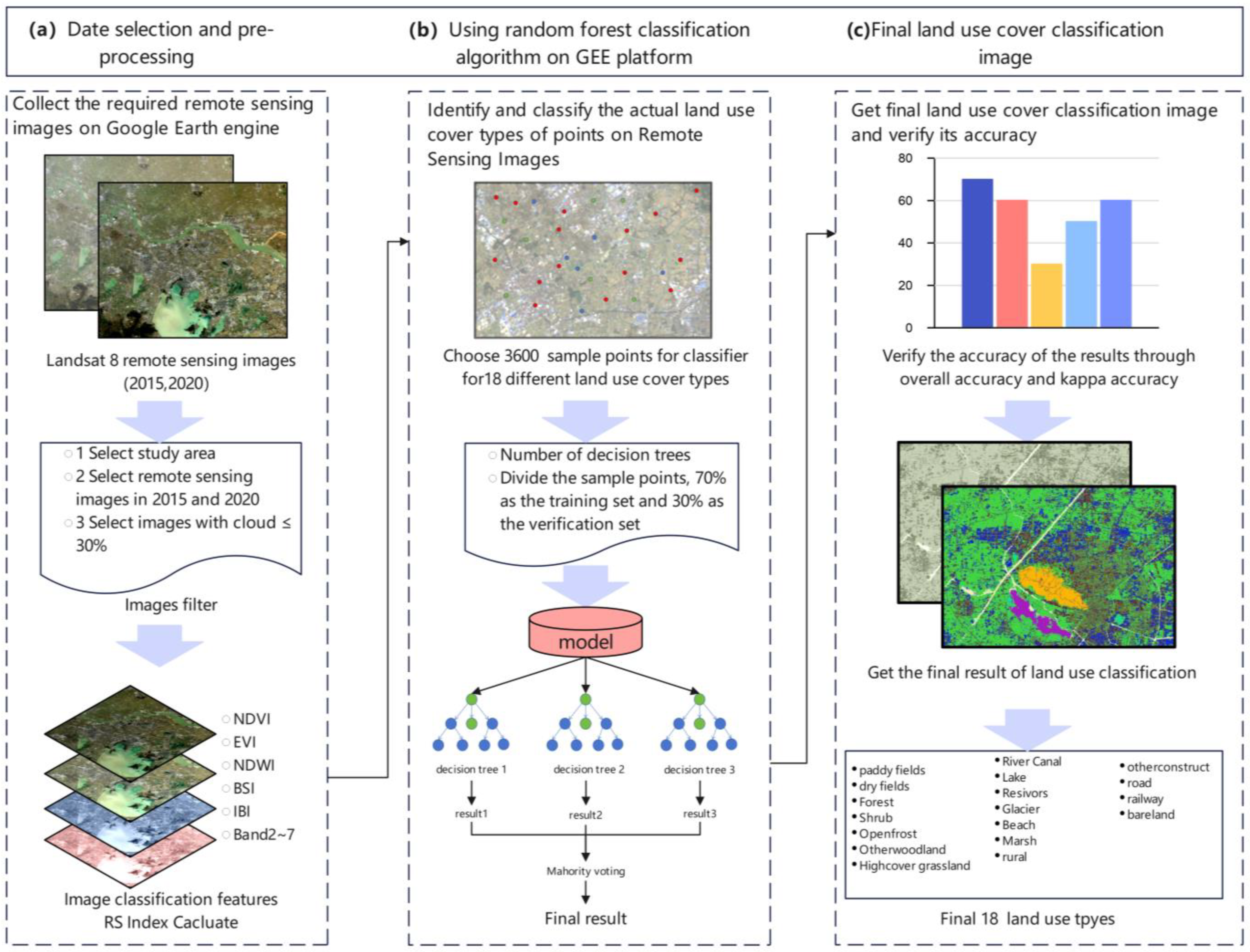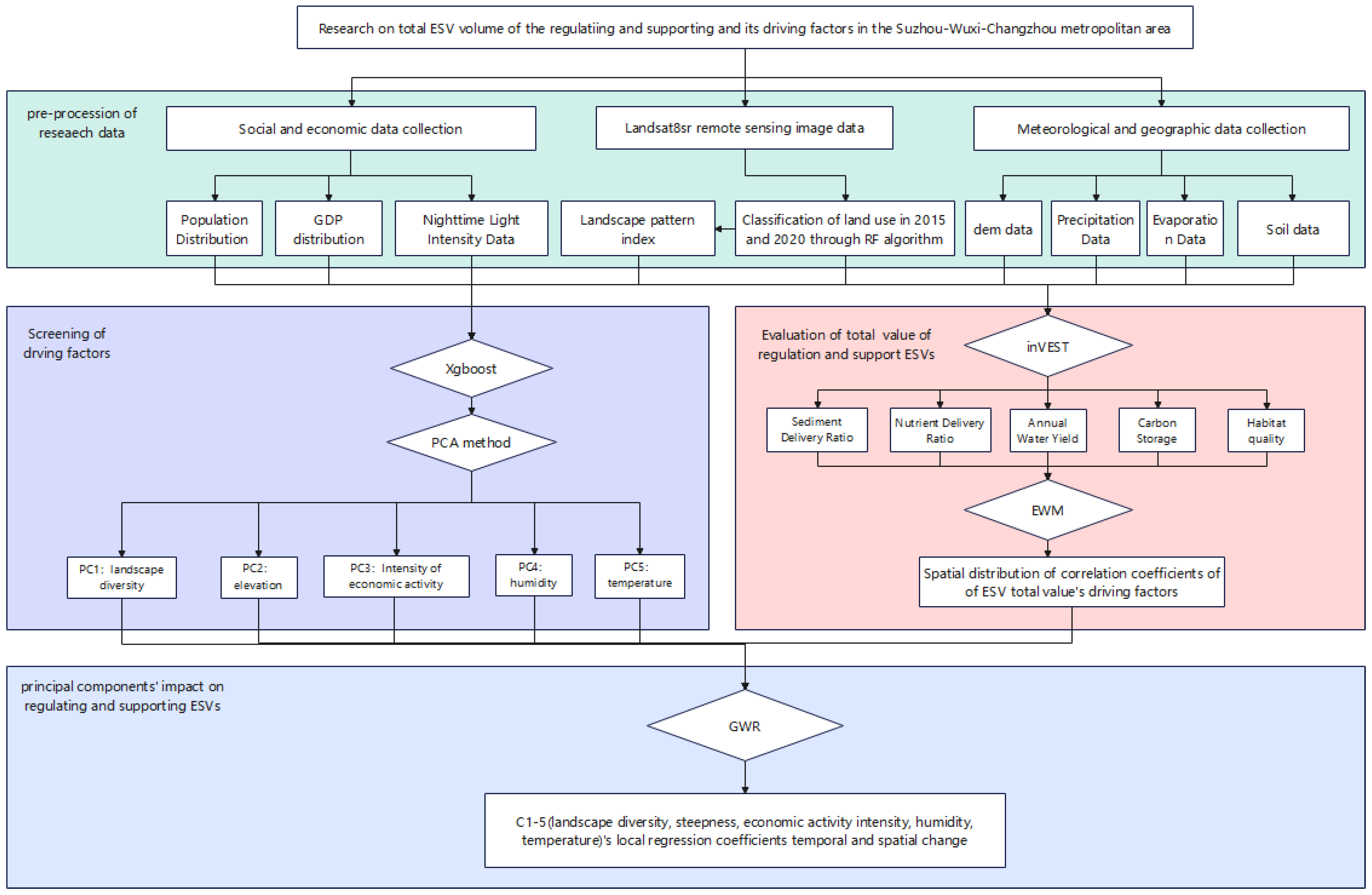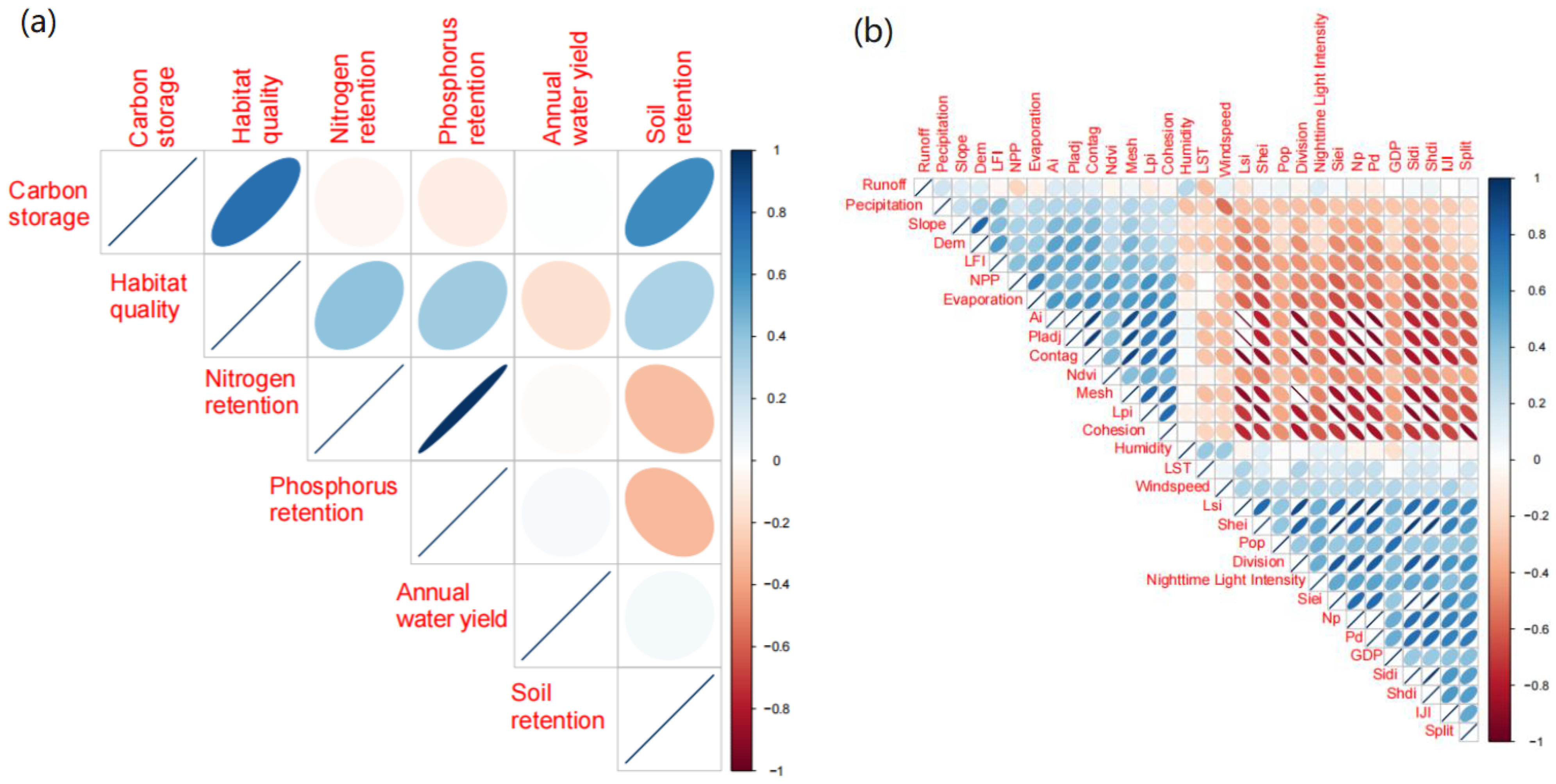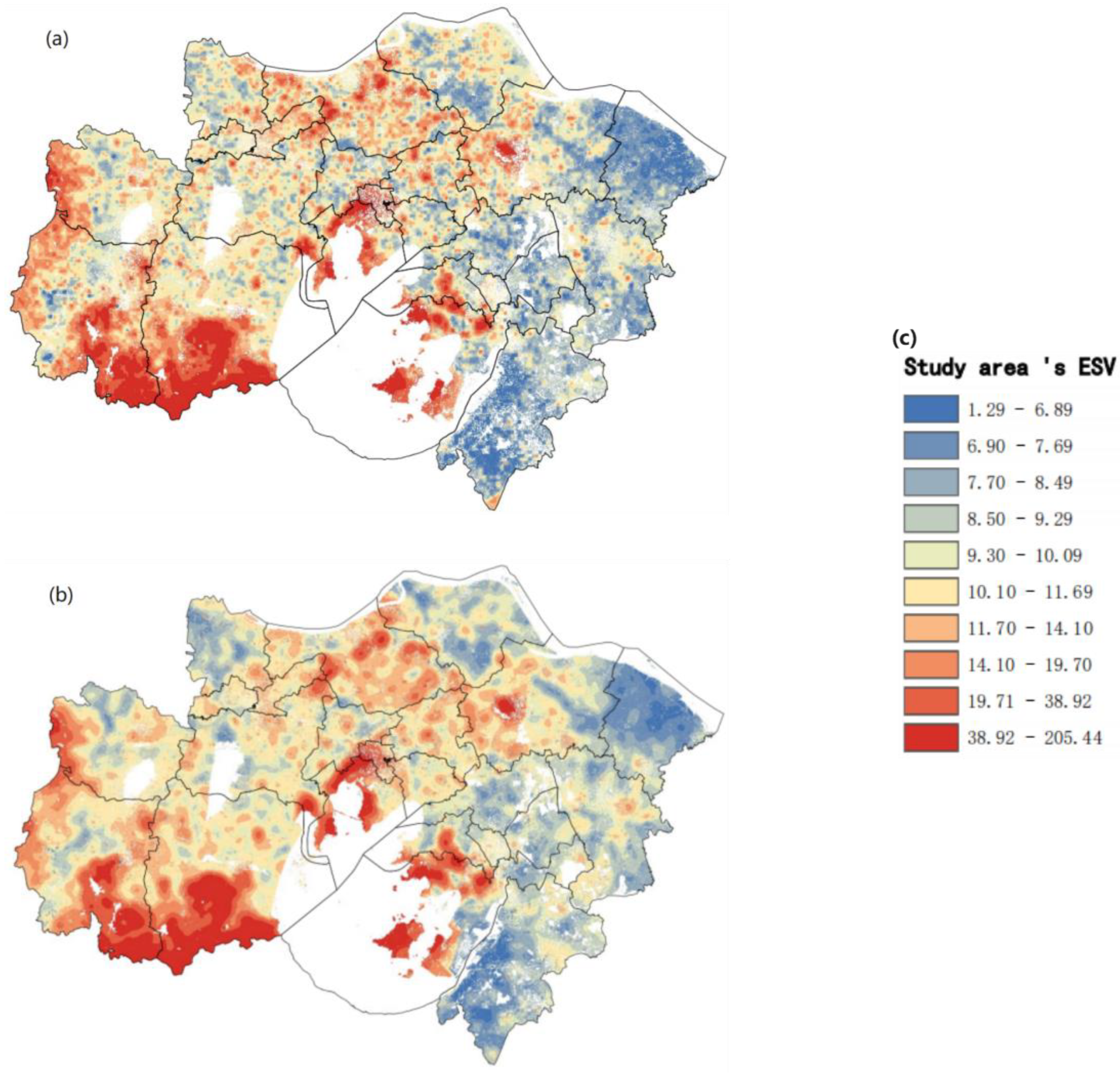Spatiotemporal Evaluation and Driving Factor Screening for Regulating and Supporting Ecosystem Service Values in Suzhou–Wuxi–Changzhou Metropolitan Area’s Green Space
Abstract
:1. Introduction
2. Materials and Methods
2.1. Study Area
2.2. Data Sources
2.3. Land Classification Process with the Random Forest Algorithm in GEE
3. Methods
3.1. inVEST Index Calculation
- (1)
- Habitat Quality
- (2)
- Annual Water Yield
- (3)
- Carbon Storage
- (4)
- Sediment Delivery Ratio
- (5)
- Nutrient Delivery Ratio
3.2. Entropy Weight Method (EWM)
3.3. Feature Importance Calculation Based on Xgboost
3.4. PCA-GWR Method
- (1)
- Principal Component Analysis
- (2)
- Geographically Weighted Regression
3.5. Overall Workflow
4. Results
4.1. Entropy Weight Method and ESV Calculation
4.2. Xgboost‘s Feature Importance and PCA Results
- (1)
- C1 (landscape diversity): With prominent loadings, including Shannon’s evenness index (SHEI = 0.98), Simpson’s diversity index (SIDI = 0.905), and Shannon’s diversity index (SHDI = 0.901), along with a negative loading for contagion index (CONTAG = −0.923), these driving factors capture the highest absolute values and are all indicators of the landscape’s aggregation metrics. Hence, C1 primarily represents landscape diversity.
- (2)
- C2 (topographic gradient): With prominent loadings, including elevation (elevation = 0.617), slope (slope = 0.563), and humidity (humidity = −0.694), these driving factors capture the highest absolute values; the elevation and slope are both indicators of the terrain metrics. C2 primarily represents the topographic gradient.
- (3)
- C3 (economic activity intensity): With prominent loadings, including gross domestic product value (GDP = 0.641) and population density (pop = 0.616), these driving factors capture the highest absolute values; the GDP and pop are both indicators of the economic metrics. C3 primarily represents economic activity intensity.
- (4)
- C4 (humidity): In this PC, the humidity is the driving factor with prominent loading (humidity = 0.634); therefore, C4 primarily represents humidity.
- (5)
- C5 (surface temperature): In this PC, the land surface temperature is the driving factor with prominent loading (LST = 0.678); therefore, C4 primarily represents surface temperature.
4.3. PCA-GWR Fitting Results
5. Discussion
5.1. C1 and Total Value of ESVs
5.2. C2 and Total Value of ESVs
5.3. C3 and Total Value of ESVs
5.4. C4 and Total Value of ESVs
5.5. C5 and Total Value of ESVs
5.6. Limitations and Future Prospects
6. Conclusions
Author Contributions
Funding
Data Availability Statement
Conflicts of Interest
References
- Han, G.; Yuan, J. The Geographic Area and Spatial Structure of Changchun Metropolitan Area. Sci. Geogr. Sin. 2014, 34, 1202–1209. [Google Scholar]
- Gao, Y.; Li, J.; Liu, R.; Wang, Z.; Wang, H.; Liu, Y. Temporal and spatial evolution of greenspace system and evaluation of ecosystem services in the core area of the Yangtze River Delta. Chin. J. Ecol. 2020, 39, 956–968. [Google Scholar]
- Tao, L.; Chen, Y.; Chen, F.; Li, H. Construction of Green Ecological Network in Qingdao (Shandong, China) Based on the Combination of Morphological Spatial Pattern Analysis and Biodiversity Conservation Function Assessment. Sustainability 2023, 15, 16579. [Google Scholar] [CrossRef]
- Costanza, R.; d’Arge, R.; De Groot, R.; Farber, S.; Grasso, M.; Hannon, B.; Limburg, K.; Naeem, S.; O’neill, R.V.; Paruelo, J. The value of the world’s ecosystem services and natural capital. Nature 1997, 387, 253–260. [Google Scholar] [CrossRef]
- Xu, K.; Yang, Z. Advances and Prospects in Research of Land Ecosystem Service Value. Asian Agric. Res. 2022, 14, 17–21. [Google Scholar]
- Sherrouse, B.C.; Semmens, D.J.; Clement, J.M. An application of Social Values for Ecosystem Services (SolVES) to three national forests in Colorado and Wyoming. Ecol. Indic. 2014, 36, 68–79. [Google Scholar] [CrossRef]
- Yirsaw, E.; Wu, W.; Temesgen, H.; Bekele, B. Effect of temporal land use/land cover changes on ecosystem services value in coastal area of China: The case of Su-Xi-Chang region. Appl. Ecol. Environ. Res. 2016, 14, 409–422. [Google Scholar] [CrossRef]
- Hamel, P.; Guerry, A.; Polasky, S.; Han, B.; Douglass, J.; Hamann, M.; Janke, B.; Kuiper, J.; Levrel, H.; Liu, H. Mapping the benefits of nature in cities with the InVEST software. npj Urban Sustain. 2021, 1, 25. [Google Scholar] [CrossRef]
- Sun, Z.; Xue, W.; Kang, D.; Peng, Z. Assessment of Ecosystem Service Values of Urban Wetland: Taking East Lake Scenic Area in Wuhan as an Example. Land 2024, 13, 1013. [Google Scholar] [CrossRef]
- Wang, J.; Wu, Y.; Gou, A. Habitat quality evolution characteristics and multi-scenario prediction in Shenzhen based on PLUS and InVEST models. Front. Environ. Sci. 2023, 11, 1146347. [Google Scholar] [CrossRef]
- Wu, Y.; Huang, Z.; Han, D.; Qiu, X.; Pan, Y. Evolution of Urban Ecosystem Service Value and a Scenario Analysis Based on Land Utilization Changes: A Case Study of Hangzhou, China. Sustainability 2023, 15, 8274. [Google Scholar] [CrossRef]
- Shi, J.; Li, S.; Song, Y.; Zhou, N.; Guo, K.; Bai, J. How socioeconomic factors affect ecosystem service value: Evidence from China. Ecol. Indic. 2022, 145, 109589. [Google Scholar] [CrossRef]
- Li, W.; Wang, L.; Yang, X.; Liang, T.; Zhang, Q.; Liao, X.; White, J.R.; Rinklebe, J. Interactive influences of meteorological and socioeconomic factors on ecosystem service values in a river basin with different geomorphic features. Sci. Total Environ. 2022, 829, 154595. [Google Scholar] [CrossRef] [PubMed]
- Chen, C.; Liu, J.; Bi, L. Spatial and temporal changes of habitat quality and its influential factors in China based on the InVEST model. Forests 2023, 14, 374. [Google Scholar] [CrossRef]
- Xiang, Q.; Kan, A.; Yu, X.; Liu, F.; Huang, H.; Li, W.; Gao, R. Assessment of topographic effect on habitat quality in mountainous area using InVEST Model. Land 2023, 12, 186. [Google Scholar] [CrossRef]
- Gong, J.; Xie, Y.; Cao, E.; Huang, Q.; Li, H. Integration of InVEST-habitat quality model with landscape pattern indexes to assess mountain plant biodiversity change: A case study of Bailongjiang watershed in Gansu Province. J. Geogr. Sci. 2019, 29, 1193–1210. [Google Scholar] [CrossRef]
- Guo, R.; Lyu, S.; Feng, J. The Effects of Urban Landscape Pattern Evolution on Habitat Quality Based on InVEST Model: A Case of Harbin City. Int. Rev. Spat. Plan. Sustain. Dev. 2023, 11, 5–25. [Google Scholar] [CrossRef] [PubMed]
- Benra, F.; De Frutos, A.; Gaglio, M.; Álvarez-Garretón, C.; Felipe-Lucia, M.; Bonn, A. Mapping water ecosystem services: Evaluating InVEST model predictions in data scarce regions. Environ. Model. Softw. 2021, 138, 104982. [Google Scholar] [CrossRef]
- Guan, X.; Wei, H.; Lu, S.; Dai, Q.; Su, H. Assessment on the urbanization strategy in China: Achievements, challenges and reflections. Habitat Int. 2018, 71, 97–109. [Google Scholar] [CrossRef]
- Li, Z.; Zhu, J.; Tian, Y. Impact of Land-Use–Land Cover Changes on the Service Value of Urban Ecosystems: Evidence from Chengdu, China. J. Urban Plan. Dev. 2024, 150, 05024028. [Google Scholar] [CrossRef]
- He, F.; Jin, J.; Zhang, H.; Yuan, L. The change of ecological service value and the promotion mode of ecological function in mountain development using InVEST model. Arab. J. Geosci. 2021, 14, 510. [Google Scholar] [CrossRef]
- Fangzheng, L.; Danlu, P.; Boya, W. Application of Research on Ecosystem Services in Landscape Planning. Landsc. Archit. Front. 2019, 7, 56–69. [Google Scholar]
- Li, J.; Luo, G.; Xu, J. Fate and ecological risk assessment of nutrients and metals in sewage sludge from ten wastewater treatment plants in Wuxi City, China. Bull. Environ. Contam. Toxicol. 2019, 102, 259–267. [Google Scholar] [CrossRef]
- Su, H. Pollution and ecological risk assessment of heavy metal of urban river sediment in Suzhou city. IOP Conf. Ser. Mater. Sci. Eng. 2018, 397, 012073. [Google Scholar] [CrossRef]
- Chen, L.; Jiang, P.; Chen, W.; Li, M.; Wang, L.; Pian, Y.; Xia, N.; Duan, Y.; Huang, Q. Farmland protection policies and rapid urbanization in China: A case study for Changzhou City. Land Use Policy 2015, 48, 552–566. [Google Scholar]
- Zhao, Q.; Yu, L.; Li, X.; Peng, D.; Zhang, Y.; Gong, P. Progress and trends in the application of Google Earth and Google Earth Engine. Remote Sens. 2021, 13, 3778. [Google Scholar] [CrossRef]
- Phan, T.N.; Kuch, V.; Lehnert, L.W. Land cover classification using Google Earth Engine and random forest classifier—The role of image composition. Remote Sens. 2020, 12, 2411. [Google Scholar] [CrossRef]
- Magidi, J.; Nhamo, L.; Mpandeli, S.; Mabhaudhi, T. Application of the random forest classifier to map irrigated areas using google earth engine. Remote Sens. 2021, 13, 876. [Google Scholar] [CrossRef]
- Liu, H.; Xiao, W.; Li, Q.; Tian, Y.; Zhu, J. Spatio-temporal change of multiple ecosystem services and their driving factors: A case study in Beijing, China. Forests 2022, 13, 260. [Google Scholar] [CrossRef]
- Zhong, L.; Wang, J. Evaluation on effect of land consolidation on habitat quality based on InVEST model. Trans. Chin. Soc. Agric. Eng. 2017, 33, 250–255. [Google Scholar]
- Nematollahi, S.; Fakheran, S.; Kienast, F.; Jafari, A. Application of InVEST habitat quality module in spatially vulnerability assessment of natural habitats (case study: Chaharmahal and Bakhtiari province, Iran). Environ. Monit. Assess. 2020, 192, 487. [Google Scholar] [CrossRef] [PubMed]
- Redhead, J.; Stratford, C.; Sharps, K.; Jones, L.; Ziv, G.; Clarke, D.; Oliver, T.; Bullock, J. Empirical validation of the InVEST water yield ecosystem service model at a national scale. Sci. Total Environ. 2016, 569, 1418–1426. [Google Scholar] [CrossRef] [PubMed]
- Yang, X.; Chen, R.; Meadows, M.E.; Ji, G.; Xu, J. Modelling water yield with the InVEST model in a data scarce region of northwest China. Water Supply 2020, 20, 1035–1045. [Google Scholar] [CrossRef]
- Huang, Z.; Zhao, J.; Xiao, H.; Guo, W.; Yang, Z.; Liu, J. Water service supply and demand situation and driving factors in Shiyang River Basin. J. Soil Water Conserv. 2021, 35, 228–235. [Google Scholar]
- Zhao, M.; He, Z.; Du, J.; Chen, L.; Lin, P.; Fang, S. Assessing the effects of ecological engineering on carbon storage by linking the CA-Markov and InVEST models. Ecol. Indic. 2019, 98, 29–38. [Google Scholar] [CrossRef]
- Matomela, N.; Li, T.; Ikhumhen, H.O.; Raimundo Lopes, N.D.; Meng, L. Soil erosion spatio-temporal exploration and Geodetection of driving factors using InVEST-sediment delivery ratio and Geodetector models in Dongsheng, China. Geocarto Int. 2022, 37, 13039–13056. [Google Scholar] [CrossRef]
- Benez-Secanho, F.J.; Dwivedi, P. Does quantification of ecosystem services depend upon scale (resolution and extent)? A case study using the InVEST nutrient delivery ratio model in Georgia, United States. Environments 2019, 6, 52. [Google Scholar] [CrossRef]
- Ji, Y.; Huang, G.H.; Sun, W. Risk assessment of hydropower stations through an integrated fuzzy entropy-weight multiple criteria decision making method: A case study of the Xiangxi River. Expert Syst. Appl. 2015, 42, 5380–5389. [Google Scholar] [CrossRef]
- Wang, Q.; Yuan, X.; Zhang, J.; Gao, Y.; Hong, J.; Zuo, J.; Liu, W. Assessment of the sustainable development capacity with the entropy weight coefficient method. Sustainability 2015, 7, 13542–13563. [Google Scholar] [CrossRef]
- Wang, G.; Li, P.; Wang, H.; Li, G. Assessments of integrated ecosystems in mining areas based on energy analysis. Acta Ecol. Sin. 2015, 35, 4367–4376. [Google Scholar]
- Ramraj, S.; Uzir, N.; Sunil, R.; Banerjee, S. Experimenting XGBoost algorithm for prediction and classification of different datasets. Int. J. Control Theory Appl. 2016, 9, 651–662. [Google Scholar]
- Zhai, L.; Li, S.; Zou, B.; Sang, H.; Fang, X.; Xu, S. An improved geographically weighted regression model for PM2.5 concentration estimation in large areas. Atmos. Environ. 2018, 181, 145–154. [Google Scholar] [CrossRef]
- Soltanifard, H.; Kashki, A.; Karami, M. Analysis of spatially varying relationships between urban environment factors and land surface temperature in Mashhad city, Iran. Egypt. J. Remote Sens. Space Sci. 2022, 25, 987–999. [Google Scholar] [CrossRef]
- Wang, S.; Fang, C.; Ma, H.; Wang, Y.; Qin, J. Spatial differences and multi-mechanism of carbon footprint based on GWR model in provincial China. J. Geogr. Sci. 2014, 24, 612–630. [Google Scholar] [CrossRef]
- Meng, L.; Huang, J.; Dong, J. Assessment of rural ecosystem health and type classification in Jiangsu province, China. Sci. Total Environ. 2018, 615, 1218–1228. [Google Scholar] [CrossRef] [PubMed]
- Kumar, E.; Subramani, T.; Karunanidhi, D. Integrated approach of ecosystem services for mine reclamation in a clustered mining semi-urban region of South India. Urban Clim. 2022, 45, 101246. [Google Scholar] [CrossRef]
- Liu, Y.-Q.; Zhang, H.-B.; Zhang, Y.-F. Spatio-temporal variation of ecosystem services value in Yancheng coastal zone. J. Zhejiang AF Univ. 2019, 36, 774–782. [Google Scholar]
- Peng, Y.; Fan, M.; Qing, F.; Xue, D. Study progresses on effects of landscape metrics on plant diversity. Ecol. Environ. Sci. 2016, 25, 1061–1068. [Google Scholar]
- Tian, T. The Effect of Landscape Patterns on Avian Communities during Summer Months in Beijing’s Urban Parks. Landsc. Archit. Front. 2016, 4, 10–22. [Google Scholar]
- Liu, C.; Liu, Y.; Giannetti, B.F.; Almeida, C.M.; Sevegnani, F.; Li, R. Spatiotemporal differentiation and mechanism of anthropogenic factors affecting ecosystem service value in the Urban Agglomeration around Poyang Lake, China. Ecol. Indic. 2023, 154, 110733. [Google Scholar] [CrossRef]
- Hou, W.; Gao, J. Simulating runoff generation and its spatial correlation with environmental factors in Sancha River Basin: The southern source of the Wujiang River. J. Geogr. Sci. 2019, 29, 432–448. [Google Scholar] [CrossRef]
- Zhang, S.-B.; Li, J.-G.; Huang, J.-H.; Zhang, W.-T.; Yang, W.-Y.; Wang, F.; Zhang, P.-P. Impact of the Grass Coverage on Runoff and Sediment in the Yili River Valley. Acta Agric. Univ. Jiangxiensis 2016, 38, 995–1001. [Google Scholar]
- Pan, D.; Qi, L.; Tian, F.; Yuan, X. Improvement of combination weighting-fuzzy clustering algorithm and its application in flood risk assessmen. South-to-North Water Transf. Water Sci. Technol. 2021, 18, 38–56. [Google Scholar]
- Li, Y.; Wang, D.; Yuan, J.; Liu, X. Temporal and spatial pattern and functional zoning of land use in alpine canyon region based on terrain gradient. Bull. Soil Water Conserv. 2020, 40, 303–311. [Google Scholar]
- Wang, B.; Yang, T. Value evaluation and driving force analysis of ecosystem services in Yinchuan City from 1980 to 2018. Arid Land Geogr. 2021, 44, 552–564. [Google Scholar]
- Wu, S.; Ma, S.; Wang, H.; Wang, L.; Jiang, J. Spatiotemporal variations of ecosystem service value in the hill and mountain belt of southern China across different altitude gradients. Chin. J. Ecol. 2023, 42, 966. [Google Scholar]
- Shasha, Z.T.; Geng, Y.; Sun, H.-p.; Musakwa, W.; Sun, L. Past, current, and future perspectives on eco-tourism: A bibliometric review between 2001 and 2018. Environ. Sci. Pollut. Res. 2020, 27, 23514–23528. [Google Scholar] [CrossRef] [PubMed]
- Jia, M.Y.; Chen, T. Identifying and Optimizing Hydro-ecological Security Pattern with Land Use Change Modeling: A Case Study of Tianjin. Landsc. Archit. 2021, 28, 95–100. [Google Scholar]
- Qin, Y.; Cheng, J.; Zhang, H.; Li, Z. A study of the raindrop impact to splash erosion. J. Soil Water Conserv. 2014, 28, 74–78. [Google Scholar]
- Chen, Z.; Zhu, B.; Tang, J.; Liu, X. Influence of slope gradient on soil erosion in the hilly area of purple soil under natural rainfall. Pearl River 2016, 37, 29–33. [Google Scholar]










| Data Number | Data Name | Source |
|---|---|---|
| 1 | Remote Sensing Imagery Data | Landsat-8 SR products |
| 2 | surface temperature Data | NASA’s MAP Level-4 (L4) Soil Moisture product |
| 3 | Wind Speed Data | NASA GESDIS Cat NASA Goddard Space Flight Center dataset |
| 4 | Humidity Data | NASA GESDIS Cat NASA Goddard Space Flight Center dataset |
| 5 | Precipitation Data | The MOD16A2 Version 6.1Precipitation |
| 6 | Evaporation Data | The MOD16A2 Version 6.1Evapotranspiration |
| 7 | Runoff Data | NASA’s MAP Level-4 (L4) Soil Moisture product |
| 8 | LFI Data | NASA’s MAP Level-4 (L4) Soil Moisture product |
| 9 | NDVI Data | Landsat8SRproducts |
| 10 | NPP Data | The MODIS Net Primary Production |
| 11 | Landscape Pattern Index Data | Calculated by Fragstats software |
| 12 | Population Distribution Data | https://www.resdc.cn/ (accessed on 15 May 2024) |
| 13 | GDP Distribution Data | https://www.resdc.cn/ (accessed on 15 May 2024) |
| 14 | Soil Data for inVEST Computation | HWSD |
| 15 | Nighttime Light Intensity Data | NPP-VIIRS |
| Number | Feature | Gain | Frequency |
|---|---|---|---|
| 1 | Slope | 0.9325973 | 0.226950355 |
| 2 | Precipitation | 0.018241357 | 0.056737589 |
| 3 | Elevation | 0.006863327 | 0.106382979 |
| 4 | Nighttime light intensity | 0.005595812 | 0.04964539 |
| 5 | NDVI | 0.003815582 | 0.042553191 |
| 6 | Evaporation | 0.003616705 | 0.056737589 |
| 7 | Pladj | 0.003088649 | 0.035460993 |
| 8 | Humdity | 0.003008886 | 0.021276596 |
| 9 | LAI | 0.002860898 | 0.035460993 |
| 10 | PD | 0.002483203 | 0.028368794 |
| 11 | SIDI | 0.00222751 | 0.021276596 |
| 12 | SHDI | 0.001854396 | 0.021276596 |
| 13 | SIEI | 0.001833174 | 0.056737589 |
| 14 | COHESION | 0.001828662 | 0.014184397 |
| 15 | GDP | 0.001471127 | 0.035460993 |
| 16 | NPP | 0.001460269 | 0.042553191 |
| 17 | LST | 0.001158324 | 0.014184397 |
| 18 | CONTAG | 0.001124751 | 0.007092199 |
| 19 | IJI | 0.001109848 | 0.042553191 |
| 20 | POP | 0.001096677 | 0.021276596 |
| 21 | Split | 0.000791577 | 0.014184397 |
| 22 | Wind speed | 0.000759522 | 0.021276596 |
| 23 | SHEI | 0.00069829 | 0.021276596 |
| 24 | LPI | 0.000414157 | 0.007092199 |
| Total Variance Explained | ||||||
|---|---|---|---|---|---|---|
| Component | Initial Eigenvalues | Extraction Sums of Squared Loadings | ||||
| Total | %of Variance | Cumulative% | Total | %of Variance | Cumulative% | |
| 1 | 11.833 | 49.306 | 49.306 | 11.833 | 49.306 | 49.306 |
| 2 | 2.187 | 9.111 | 58.417 | 2.187 | 9.111 | 65.417 |
| 3 | 1.700 | 7.082 | 65.499 | 1.700 | 7.082 | 72.499 |
| 4 | 1.335 | 5.563 | 71.063 | 1.335 | 5.563 | 77.063 |
| 5 | 1.260 | 5.252 | 76.314 | 1.260 | 5.252 | 81.314 |
| Component Matrix | |||||
|---|---|---|---|---|---|
| Factors | Component | ||||
| 1 | 2 | 3 | 4 | 5 | |
| Slope | −0.439 | 0.563 | 0.168 | 0.500 | 0.047 |
| Precipitation | −0.400 | 0.504 | −0.332 | −0.261 | −0.098 |
| Elevation | −0.539 | 0.617 | 0.184 | 0.406 | −0.004 |
| Nighttime light intensity | 0.654 | 0.064 | 0.294 | 0.291 | 0.015 |
| NDVI | −0.576 | −0.039 | −0.014 | −0.104 | 0.349 |
| Evaporation | −0.746 | 0.002 | −0.061 | −0.013 | 0.335 |
| Pladj | −0.875 | −0.010 | 0.086 | 0.215 | −0.258 |
| Humidity | 0.110 | −0.604 | −0.190 | 0.634 | −0.058 |
| LFI | −0.604 | 0.393 | −0.245 | 0.203 | 0.119 |
| PD | 0.891 | 0.112 | −0.014 | −0.152 | 0.225 |
| SIDI | 0.905 | 0.107 | −0.283 | 0.053 | −0.066 |
| SHDI | 0.901 | 0.116 | −0.273 | 0.067 | −0.064 |
| COHESION | −0.850 | −0.297 | −0.070 | −0.108 | −0.225 |
| GDP | 0.557 | 0.092 | 0.641 | −0.163 | 0.066 |
| LST | 0.229 | −0.346 | −0.236 | 0.271 | 0.678 |
| NPP | −0.667 | 0.031 | 0.070 | −0.149 | 0.474 |
| CONTAH | −0.923 | −0.024 | 0.080 | 0.158 | −0.193 |
| IJI | 0.706 | 0.169 | 0.109 | −0.015 | 0.047 |
| POP | 0.538 | 0.054 | 0.616 | −0.042 | −0.010 |
| Split | 0.713 | 0.305 | 0.127 | 0.121 | 0.257 |
| Windspeed | 0.402 | −0.518 | 0.356 | 0.191 | −0.056 |
| SHEI | 0.928 | 0.050 | −0.219 | 0.027 | −0.110 |
| LPI | −0.877 | −0.226 | 0.202 | −0.149 | 0.077 |
| SIEI | 0.916 | 0.090 | −0.270 | 0.042 | −0.079 |
| Principal Components | Meaning | Moran’s I | Z-Value | p-Value | |||
|---|---|---|---|---|---|---|---|
| 2015 | 2020 | 2015 | 2020 | 2015 | 2020 | ||
| C1 | landscape diversity | 0.711 | 0.734 | 256.800 | 229.993 | 0.000 | 0.000 |
| C2 | topographic gradient | 0.698 | 0.728 | 252.199 | 227.970 | 0.000 | 0.000 |
| C3 | economic activity intensity | 0.708 | 0.732 | 255.739 | 229.252 | 0.000 | 0.000 |
| C4 | humidity | 0.709 | 0.734 | 256.165 | 229.874 | 0.000 | 0.000 |
| C5 | surface temperature | 0.707 | 0.735 | 255.432 | 230.233 | 0.000 | 0.000 |
Disclaimer/Publisher’s Note: The statements, opinions and data contained in all publications are solely those of the individual author(s) and contributor(s) and not of MDPI and/or the editor(s). MDPI and/or the editor(s) disclaim responsibility for any injury to people or property resulting from any ideas, methods, instructions or products referred to in the content. |
© 2024 by the authors. Licensee MDPI, Basel, Switzerland. This article is an open access article distributed under the terms and conditions of the Creative Commons Attribution (CC BY) license (https://creativecommons.org/licenses/by/4.0/).
Share and Cite
Shi, T.; Xu, H.; Bai, X. Spatiotemporal Evaluation and Driving Factor Screening for Regulating and Supporting Ecosystem Service Values in Suzhou–Wuxi–Changzhou Metropolitan Area’s Green Space. Land 2024, 13, 1191. https://doi.org/10.3390/land13081191
Shi T, Xu H, Bai X. Spatiotemporal Evaluation and Driving Factor Screening for Regulating and Supporting Ecosystem Service Values in Suzhou–Wuxi–Changzhou Metropolitan Area’s Green Space. Land. 2024; 13(8):1191. https://doi.org/10.3390/land13081191
Chicago/Turabian StyleShi, Tailon, Hao Xu, and Xuefeng Bai. 2024. "Spatiotemporal Evaluation and Driving Factor Screening for Regulating and Supporting Ecosystem Service Values in Suzhou–Wuxi–Changzhou Metropolitan Area’s Green Space" Land 13, no. 8: 1191. https://doi.org/10.3390/land13081191




